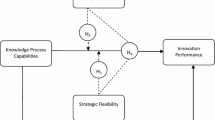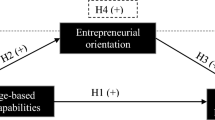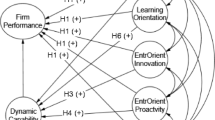Boeing has 100,000 Dell PCs…we have 30 people that live at Boeing….We look more like Boeing’s PC department. We become intimately involved in planning their PC needs and in configuring their network. Virtual integration means you basically stitch together a business with partners that are treated as if they are inside the company.—Michael Dell, HBR interview in 1998.
Abstract
There has been tremendous growth in research on Dynamic Capabilities (DCs) since its inception. However, some aspects such as micro-foundations, path dependence, moderator influences, and applicability in countries such as India have not been explored with sufficient clarity. We contribute by simultaneously examining the impact of managers’ knowledge and Customer-Focused Knowledge Management, respectively, in the process leading to innovation performance. Using survey data from Indian managers, we find support for the theoretical model. We also find support for the moderating impact of intra-firm causal ambiguity. We contribute by showing that a combination of dynamic managerial capabilities and DCs can help organizations in identifying paths to competitive advantage that have higher likelihood of being actionable and lower likelihood of stickiness and irreversibility. We discuss findings, articulate contributions, limitations, and directions for future research.



Similar content being viewed by others
Notes
We conceive of customers as different from end users and hence treat customers as distinct entities vis-à-vis focal organizations.
References
Adner, R., & Helfat, C. E. (2003). Corporate effects and dynamic managerial capabilities. Strategic Management Journal, 24, 1011–1025.
Aiken, L. S., & West, S. G. (1991). Multiple regression: Testing and interpreting interactions. Sage.
Armstrong, J. S., & Overton, T. S. (1977). Estimating non response in mail surveys. Journal of Marketing Research, 16, 396–400.
Augier, M., & Teece, D. J. (2009). Dynamic capabilities and the role of managers in business strategy and economic performance. Organization Science, 20, 410–421.
Barney, J. B. (1991). Firm resources and sustained competitive advantage. Journal of Management, 17, 99–120.
Bingham, C. B., Heimeriks, K. H., Schijven, M., & Gates, S. (2015). Concurrent learning: How firms develop multiple dynamic capabilities in parallel. Strategic Management Journal, 36, 1802–1825.
Burns, J. M. (1978). Leadership. Harper & Row.
Eisenhardt, K. M., & Martin, J. A. (2000). Dynamic capabilities: What are they? Strategic Management Journal, 21, 1105–1121.
Ethiraj, S. K., Ramasubbu, N., & Krishnan, M. S. (2012). Does complexity deter customer focus? Strategic Management Journal, 33, 177–161.
Ethiraj, S. K., Kale, P., Krishnan, M. S., & Singh, J. V. (2005). Where do Capabilities come from and how do they matter? A Study in the Software Services Industry. Strategic Management Journal, 26, 25–45.
Faems, D., Janssens, M., & Van Looy, B. (2007). The initiation and evolution of interfirm knowledge transfer in R&D relationships. Organization Studies, 28(11), 1699–1728.
Felin, T., & Hesterly, W. S. (2007). The knowledge-based view, nested heterogeneity, and new value creation: Philosophical considerations on the locus of knowledge. Academy of Management Review, 32(1), 195–218.
Fornell, C., & Larcker, D. (1981). Evaluating structural equation models with unobservable variables and measurement error. Journal of Marketing Research, 18, 39–50.
Helfat, C. E., & Martin, J. A. (2015). Dynamic managerial capabilities: Review and assessment of managerial impact on strategic change. Journal of Management, 41(5), 1281–1312.
Heyden, M. L. M., Van Doorn, S., Reimer, M., Van Den Bosch, F. A. J., & Volberda, H. W. (2013). perceived environmental dynamism, relative competitive performance, and top management team heterogeneity: Examining correlates of upper echelons’ advice-seeking. Organization Studies, 34(9), 1327–1356.
House, R., Hanges, P., Javidan, M., Dorfman, P., & Gupta, V. (Eds.). (2004). Culture, leadership, and organizations: The GLOBE study of 62 societies. Sage Publications.
King, A. W. (2007). Disentangling interfirm and intrafirm causal ambiguity: A conceptual model of causal ambiguity and competitive advantage. Academy of Management Review, 32, 156–178.
Kor, Y. Y., & Mesko, A. (2013). Dynamic managerial capabilities: Configuration and orchestration of top executives’ capabilities and the firm’s dominant logic. Strategic Management Journal, 34, 233–244.
Lakshman, C. (2009). Organizational knowledge leadership: An empirical examination of knowledge management by top executive leaders. Leadership & Organization Development Journal, 30, 338–364.
Lakshman, C., & Parente, R. (2008). Supplier-focused knowledge management in the automobile industry and its implications for product performance. Journal of Management Studies, 45, 317–342.
Lakshman, C. (2015). Doing business in India: A framework for strategic understanding. Elsevier Publishing.
Lakshman, C., Kumra, R., & Adhikari, A. (2017). Proactive market orientation and innovation in India: The moderating role of intrafirm causal Ambiguity. Journal of Management & Organization, 23, 116.
Lakshman, C., & Rai, S. (2019). The influence of leadership on learning and innovation: Evidence from India. Asian Business & Management. https://doi.org/10.1057/s41291-019-00096-w
Lakshman, C., Wang, L., Adhikari, A., & Cheng, G. (2020). Flexibility-oriented HRM practices and Innovation: Evidence from China and India. International Journal of Human Resource Management, 2, 89. https://doi.org/10.1080/09585192.2020.1861057
Magretta, J. (1998). The power of virtual integration: An interview with Dell computers’ Michael Dell. Harvard Business Review 72–85.
Lu, Y., Zhou, L., Bruton, G., & Li, W. (2010). Capabilities as a mediator linking resources and the international performance of entrepreneurial firms in an emerging economy. Journal of International Business Studies, 41, 419–436.
Malik, A., Periera, V., & Budhwar, P. (2020a). HRM in the global information technology (IT) industry: Towards multivergent configurations in strategic business partnerships. Human Resource Management Review. https://doi.org/10.1016/j.hrmr.2020.100743
Malik, A., Froese, F. J., & Sharma, P. (2020b). Role of HRM in knowledge integration: Towards a conceptual framework. Journal of Business Research. https://doi.org/10.1016/j.jbusres.2019.01.029
Malik, A., Pereira, V., & Tarba, S. (2019a). The role of HRM practices in product development: Contextual ambidexterity in a US MNCs subsidiary in India. The International Journal of Human Resource Management, 30, 536–564.
Malik, A., Sinha, P., Pereira, V., & Rowley, C. (2019b). Implementing global-local strategies in a post -GFC era: Creating an ambidextrous context through strategic choice and HRM. Journal of Business Research, 103, 557–569.
Malik, A., Boyle, B., & Mitchell, R. (2017). Contextual ambidexterity and innovation in healthcare in India: The role of HRM. Personnel Review, 46, 1358–1380.
McIver, D., & Lengnick-Hall, C. (2018). The causal ambiguity paradox: Deliberate actions under causal ambiguity. Strategic Organization, 16(3), 304–322.
Mol, M. J., & Birkinshaw, J. (2014). The role of external involvement in the creation of management innovation. Organization Studies, 35(9), 1287–1312.
Narver, J. C., Slater, S. F., & MacLachlan, D. L. (2004). Responsive and proactive market orientation and new-product success. The Journal of Product Innovation Management, 21, 334–347.
Patnaik, S., Pereira, V., Temouri, Y., Malik, A., & Roohanifar, M. (2020). The dance of power and trust-exploring micro foundational dimensions in the development of global health partnership. Technological Forecasting and Social Change. https://doi.org/10.1016/j.techfore.2020.120036
Podsakoff, P. M., MacKenzie, S. B., & Podsakoff, N. P. (2012). Sources of method bias in social science research and recommendations on how to control it. Annual Review of Psychology, 65, 539–569.
Prange, C., Bruyaka, O., & Marmenout, K. (2017). Investigating the transformation and transition processes between dynamic capabilities: Evidence from DHL. Organization Studies, 38, 1–27.
Rosenbloom, R. S. (2000). Leadership, capabilities, and technological change: The transformation of NCR in the electronic era. Strategic Management Journal, 21, 1083–1103.
Salvato, C., & Vassolo, R. (2018). The sources of dynamism in dynamic capabilities. Strategic Management Journal, 39(6), 1728–1752.
Schilke, O., Hu, S., & Helfat, C. E. (2018). Quo Vadis, dynamic capabilities? A content-analytic review of the current state of knowledge and recommendations for future research. Academy of Management Annals, 12(1), 390–439.
Szulanski, G., Cappetta, R., & Jensen, R. J. (2004). When and how trustworthiness matters: Knowledge transfer and the moderating role of causal ambiguity. Organization Science, 15(5), 600–613.
Teece, D. J. (2007). Explicating dynamic capabilities: The nature and micro foundations of (sustainable) enterprise performance. Strategic Management Journal, 28, 1319–1350.
Teece, D. J. (2012). Dynamic capabilities: Routines versus entrepreneurial action. Journal of Management Studies, 49, 1395–1401.
Teece, D. J., Pisano, G., & Shuen, A. (1997). Dynamic capabilities and strategic management. Strategic Management Journal, 18, 509–533.
Uygur, U. (2013). Determinants of causal ambiguity and difficulty of knowledge transfer within the firm. Journal of Management & Organization, 19(6), 742–765.
Vergne, J. P., & Durand, R. (2011). The path of most persistence: An evolutionary perspective on path dependence and dynamic capabilities. Organization Studies, 32(3), 365–382.
Wilden, R., Devinney, T. M., & Dowling, G. R. (2016). The architecture of dynamic capability research identifying the building blocks of a configurational approach. Academy of Management Annals, 10(1), 997–1076.
Williams, L. J., Vandenbergh, R. J., & Edwards, J. R. (2009). Structural equation modeling in management research: A guide for improved analysis. The Academy of Management Annals, 3, 543–604.
Zollo, M., & Winter, S. (2002). Deliberate learning and the evolution of dynamic capabilities. Organization Science, 13(3), 339–351.
Acknowledgements
We thank the anonymous reviewers and the Associate Editor for their excellent feedback throughout the review process.
Author information
Authors and Affiliations
Corresponding author
Additional information
Publisher's Note
Springer Nature remains neutral with regard to jurisdictional claims in published maps and institutional affiliations.
Rights and permissions
About this article
Cite this article
Lakshman, C., Lakshman, S. & Gok, K. Managers’ knowledge and customer-focused knowledge management as dynamic capabilities: implications for innovation performance. Asian Bus Manage 22, 246–274 (2023). https://doi.org/10.1057/s41291-021-00165-z
Received:
Revised:
Accepted:
Published:
Issue Date:
DOI: https://doi.org/10.1057/s41291-021-00165-z




